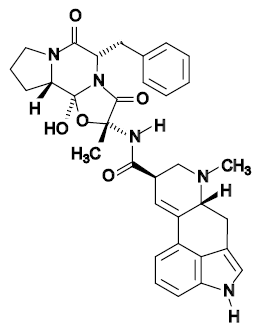Ergotamine tartrate (sublingual tablet)
 | |
| Clinical data | |
|---|---|
| Routes of administration | Oral |
| ATC code | |
| Legal status | |
| Legal status | |
| Pharmacokinetic data | |
| Metabolism | hepatic |
| Excretion | renal |
| Identifiers | |
| |
| CAS Number | |
| PubChem CID | |
| E number | {{#property:P628}} |
| ECHA InfoCard | {{#property:P2566}}Lua error in Module:EditAtWikidata at line 36: attempt to index field 'wikibase' (a nil value). |
| Chemical and physical data | |
| Formula | C33H35N5O5 |
| Molar mass | 581.66 g/mol |
Ergotamine is an ergopeptine and part of the ergot family of alkaloids; it is structurally and biochemically closely related to ergoline. It possesses structural similarity to several neurotransmitters, and has biological activity as a vasoconstrictor. It is used medicinally for migraine prevention (sometimes in combination with caffeine), and to induce childbirth and prevent post-partum haemorrhage.
Mechanism of action
The mechanism of action of ergotamine is complex. The molecule shares similarity with neurotransmitters such as serotonin, dopamine, and adrenaline and can thus bind to several cell receptors acting both as agonist and antagonist in signal transduction within cellular tissues. The anti-migraine effect is due to constriction of the intercranial extracerebral blood vessels through the 5-HT1B receptor, and by inhibiting trigeminal neurotransmission by 5-HT1D receptors. Ergotamine also has effects on the dopamine and noradrenaline receptors. It is its action on the D2 dopamine and 5-HT1A receptors that can cause some side effects. [1]
Biosynthesis
Ergotamine is a secondary metabolite (natural product) and the principal alkaloid produced by the ergot fungus, Claviceps purpurea, and related fungi in the family Clavicipitaceae. Its biosynthesis in these fungi requires the amino acid, L-tryptophan, and dimethylallyl diphosphate. These precursor compounds are the substrates for the enzyme, dimethylally-tryptophan (DMAT) synthase, catalyzing the first step in ergot alkaloid biosynthesis, i.e., the prenylation of L-tryptophan. Further reactions, involving methyltransferase and oxygenase enzymes, yield the ergoline, lysergic acid. Lysergic acid (LA) is the substrate of lysergyl peptide synthetase, a nonribosomal peptide synthetase, which covalently links LA to the amino acids, L-alanine, L-proline, and L-phenylalanine. Enzyme-catalyzed or spontaneous cyclizations, oxygenations/oxidations, and isomerizations at selected residues precede, and give rise to, formation of ergotamine.[2]
Illegal uses
Ergotamine is also a precursor of LSD, lysergic acid diethylamide.
See also
References
- ↑ Tfelt-Hansen P, Saxena PR, Dahlof C, Pascual J, Lainez M, Henry P, Diener H, Schoenen J, Ferrari MD, Goadsby PJ (2000). "Ergotamine in the acute treatment of migraine: a review and European consensus". Brain. 123: 9–18. PMID 10611116.
- ↑ Schardl CL, Panaccione DG, Tudzynski P (2006). "Ergot alkaloids--biology and molecular biology". Alkaloids Chem. Biol. 63: 45–86. PMID 17133714.
Template:Antimigraine preparations
- Pages with script errors
- CS1 maint: Multiple names: authors list
- E number from Wikidata
- ECHA InfoCard ID from Wikidata
- Chemical articles with unknown parameter in Infobox drug
- Articles without EBI source
- Chemical pages without ChemSpiderID
- Chemical pages without DrugBank identifier
- Articles without KEGG source
- Articles without InChI source
- Articles without UNII source
- Articles containing unverified chemical infoboxes
- Antimigraine drugs
- DEA List I chemicals